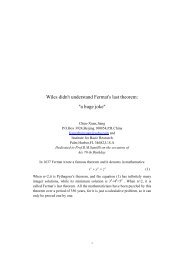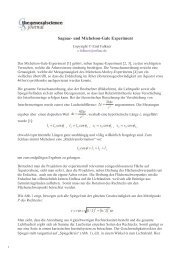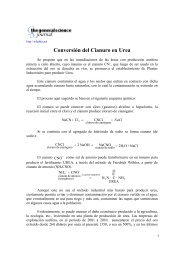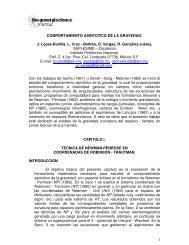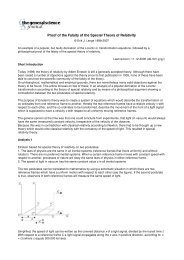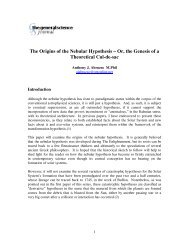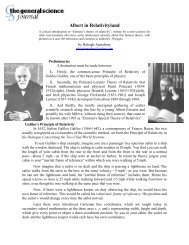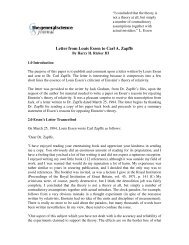MAGNETISM DURING THE SEVENTEENTH CENTURY HH Ricker III
MAGNETISM DURING THE SEVENTEENTH CENTURY HH Ricker III
MAGNETISM DURING THE SEVENTEENTH CENTURY HH Ricker III
Create successful ePaper yourself
Turn your PDF publications into a flip-book with our unique Google optimized e-Paper software.
power, like “visible images, light, or, equally, like the various influences that celestial bodies<br />
exert upon things down here on the Earth.”<br />
Leótaud urged that this magnetic power was drawn from the earth, and was not inherent within<br />
the loadstone:<br />
”For if a loadstone is not oriented in concordance with the Earth, its magnetic property is<br />
lost; or at least it is lessened [while] fragmented loadstones show that the magnetic property is<br />
unique, simple, and homogenous, and occupies the whole magnetic body.”<br />
This is not very clear until we consider what he is aiming at. Leótaud is thinking that the<br />
magnetic power is drawn from the earth as a gigantic magnet. This power is communicated to<br />
magnets but its effectiveness depends on their orientation. Improperly oriented magnets do not<br />
possess the power and unless all the individual portions of a loadstone are properly ordered, the<br />
magnetic power is not present within its sphere of influence.<br />
Here we find the first intimation of the idea of magnetic domains. This is one reason why<br />
Leótaud’s ideas have attracted the interest of historians of science. But, Leótaud doesn’t really<br />
have this in mind. He is aiming at two basic facts. He wants to explain why iron is not magnetic<br />
until it approaches the sphere of influence of a loadstone, and to develop a field concept that<br />
explains why the magnetic action appears at the poles as opposed to uniformly distributed in<br />
space.<br />
Leótaud’s theory appears to be based on a single experiment which brings to his mind the idea<br />
that magnets derive their power from the earth, and without this, the resulting power is impotent.<br />
The experiment consists of taking a loadstone and filing it down into small particles of loadstone<br />
dust. These are then packed into a paper tube with the following result as Leótaud says:<br />
”...we do not observe any phenomenon of orientation because of the disorder of the<br />
loadstone particles, and it is in reason of this same disorder that we must explain how iron is<br />
deprived of magnetic property until it suffers the influence of a loadstone which gives to all its<br />
particles the property and energy along the same orientation.” 10<br />
Leotaud interprets this as the explanation why iron is not magnetic. When it is removed from its<br />
vein within the mine, smelted and then poured into a mould, its particles are like the loadstone<br />
power win the paper tube. They are disordered. But then when a magnet is brought near, they<br />
again receive the power to attract.<br />
Leotaud also applied this idea to the mathematical calculation of the sphere of influence.<br />
”Leotaud disagrees with both Gilbert and Cabeo on the thesis that the poles of a<br />
loadstone are not merely points of the resultant magnetic forces of the whole magnet, but also the<br />
natural loci from which the magnetic force spreads out in waves. Rather, Leotaud argues, the<br />
magnetic force is spread out in all directions from every point of the loadstone taken as a small,<br />
elementary magnet. The loadstone poles, he continues are but the loci of the resultants, or<br />
integration in our modern view, of the forces of all such elementary magnets.” 10



